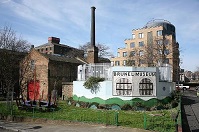 The first ever project built by engineer Isambard Kingdom Brunel – London’s underwater Thames Tunnel – has just reopened to the public as a new attraction, exhibition space and concert hall. It forms part of London’s Brunel Museum.
The first ever project built by engineer Isambard Kingdom Brunel – London’s underwater Thames Tunnel – has just reopened to the public as a new attraction, exhibition space and concert hall. It forms part of London’s Brunel Museum.
The tunnel was built by the young Brunel and his father in the mid-19th century to connect the districts of Rotherhithe and Wapping and is now part of London’s rail network.
A freestanding, cantilevered staircase and viewing platform has been constructed to enable access down the tunnel’s 65ft entrance shaft into the Grand Entrance Hall which is half the size of Shakespeare’s Globe Theatre and is available as gallery or performance space.
The Brunel Museum is a converted industrial building. Facilities include the Engine House - one large space divided into Upper Gallery, Lower Gallery and a mezzanine accommodating up to a hundred delegates on the upper level and sixty on the lower. A marquee is also available for extra space.
The Brunel Museum is easily accessible via Canada Water on the Jubilee Line and Rotherhithe station on the London Overground. It is two minutes from the Rotherhithe Road Tunnel and ten minutes from Tower Bridge by road.
Rotherhithe was an East India Company Town long before it was a crossing point on the Thames. The Tunnel was designed to move ships’ cargo. From these jetties the Pilgrim Fathers left for the New World on the Mayflower. The re-opening coincides with the 210th anniversary of Brunel's birth.
Details: http://www.brunel-museum.org.uk/













































































































































































































































































































































































































































